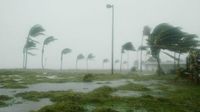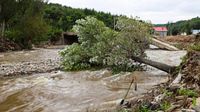As Typhoon Matmo barreled across southern China and Southeast Asia in early October 2025, communities from Guangdong to northern Vietnam braced for a storm that would upend daily life, disrupt holiday celebrations, and test emergency response systems across the region. The typhoon, which reached sustained winds of up to 104 miles per hour—equivalent to a Category 2 hurricane—made landfall in China's Guangdong Province on October 5, 2025, after churning through the South China Sea, according to reporting from multiple outlets, including Travel + Leisure Asia and official Chinese meteorological sources.
Matmo’s impact was immediate and far-reaching. In Guangdong alone, more than 151,000 residents were evacuated as the storm approached, with China’s overall evacuation tally exceeding 347,000 people. The typhoon’s destructive path took it across Hainan Island—where cities like Haikou and Wenchang suffered some of the worst damage—before moving inland through Guangxi Province and toward northern Vietnam. As the system continued northwest at a brisk 20–25 kilometers per hour, it weakened into a tropical depression, but not before leaving a trail of flooding, transportation chaos, and widespread disruption in its wake.
The timing of the storm could hardly have been worse for China. Typhoon Matmo struck during the country’s much-anticipated eight-day holiday break, which began with National Day on October 1. Known as the “Golden Week,” this period typically sees millions traveling for family reunions, shopping, and leisure activities. Airports, train stations, and tourist attractions swell with record-breaking crowds, and the nation’s retail and tourism sectors count on the holiday for a major boost in consumer spending. This year, however, the typhoon forced a dramatic change of plans.
In southern China, the response to Matmo was swift and sweeping. Authorities in Guangdong and Hainan suspended transportation, closed schools, and halted ferry routes as part of emergency precautions. According to Travel + Leisure Asia, at Haikou Meilan Airport—the busiest on Hainan Island—multiple flights were canceled, and ferry services along the southern coast were suspended. Across the region, approximately 100 flights were affected, with 30 cancellations in Hong Kong alone. Businesses, schools, and roads shut down in cities such as Zhanjiang, while tourist spots closed in Guangxi Province as heavy rains and flooding risks mounted.
Hong Kong, always vigilant during typhoon season, issued a No. 3 Strong Wind Signal as Matmo approached, later downgrading the alert as the storm weakened. Still, travelers faced delays and disruptions, and the city’s bustling pace slowed as residents took shelter from the wind and rain. The National Meteorological Centre of China issued a red-level typhoon warning—the highest in its system—underscoring the seriousness of the threat.
As Matmo moved inland, its effects rippled across the broader region. In Guangxi Province, authorities warned of flooding, prompting the closure of tourist sites and the implementation of further safety measures. The storm’s center was last located over southern Guangxi, with forecasts predicting continued movement toward Yunnan Province in China and northern Vietnam before eventual dissipation. Meteorological data showed Matmo’s peak intensity included maximum sustained winds ranging from 104 to 151 kilometers per hour, with heavy rainfall totals of 100–200 millimeters—and localized amounts exceeding 300 millimeters—across northern Vietnam.
Vietnamese disaster management authorities responded by placing a level 3 disaster risk alert across northern provinces, urging residents to prepare for flash floods and landslides. Key areas under watch included Hanoi, Quang Ninh, and Lang Son. Meanwhile, in Thailand, the Meteorological Department warned residents in northern, northeastern, eastern, and southern regions to remain on high alert for flash floods, runoff, and overflowing rivers until at least October 7. The storm’s interaction with the southwest monsoon intensified rainfall, with waves reaching up to 2 meters along the coast.
For travelers and locals alike, the storm’s arrival was a jarring interruption. “The typhoon reached wind speeds of up to 151 km/h and disrupted transportation along China’s southern coast, leading to suspended ferry services,” Travel + Leisure Asia reported. The publication also noted that the storm’s timing—coinciding with the Golden Week holiday—meant that shopping festivals, discounts, and leisure activities were put on hold, with many families forced to shelter in place or postpone trips. In Wuchuan (Guangdong) and Wenchang (Hainan), some of the hardest-hit areas, residents faced battering winds and relentless rain, while cities like Chongzou, Qinzhou, and Nanning in Guangxi were inundated by downpours.
Authorities across the affected regions implemented a range of safety measures to minimize casualties and property loss. In addition to mass evacuations, transportation networks were suspended, and emergency shelters opened their doors to those displaced by flooding. The response was coordinated and robust, reflecting lessons learned from past storms and the increasing frequency of extreme weather events linked to climate change.
For those returning to flooded homes, the risk of mold was a pressing concern. Health experts and disaster response agencies advised residents to take immediate steps to prevent mold growth: ensuring the area was safe before entry, wearing protective gear such as gloves and KN95 or FFP2 masks, and removing standing water as quickly as possible. The first 24 to 48 hours after flooding are crucial for drying out affected spaces, using fans, dehumidifiers, and HVAC systems to promote air circulation. Severely water-damaged items—like carpets, mattresses, and upholstered furniture—should be discarded if they can’t be thoroughly cleaned and dried. Hard surfaces require thorough cleaning with appropriate detergents, and a bleach solution (never mixed with ammonia) can be used to disinfect nonporous surfaces. Maintaining indoor humidity between 35-50% and using high-performance air purifiers further reduces the risk of mold. In cases of extensive damage, professionals specializing in mold remediation may be necessary. Persistent health issues linked to mold exposure should prompt consultation with a medical professional.
As Typhoon Matmo continued its journey, the storm served as a stark reminder of the vulnerability of densely populated, low-lying coastal regions during typhoon season. The rapid, coordinated response by authorities in China, Vietnam, and Thailand helped limit the worst outcomes, but the disruption to millions—particularly during a cherished holiday period—was impossible to ignore. With climate patterns shifting and storms becoming more intense, communities across East and Southeast Asia are left to reckon with the new normal: preparation, resilience, and the hope that the next storm will pass with as little harm as possible.

